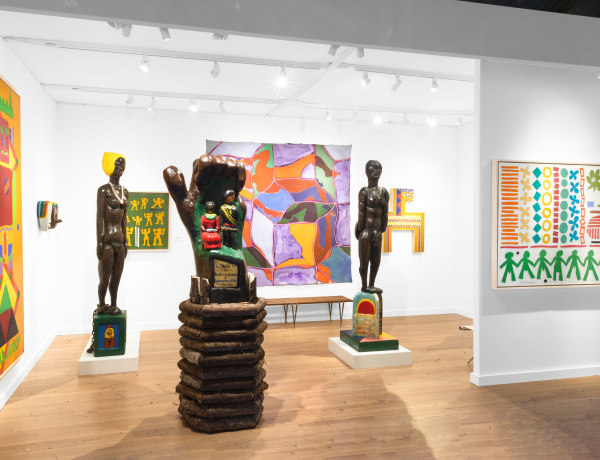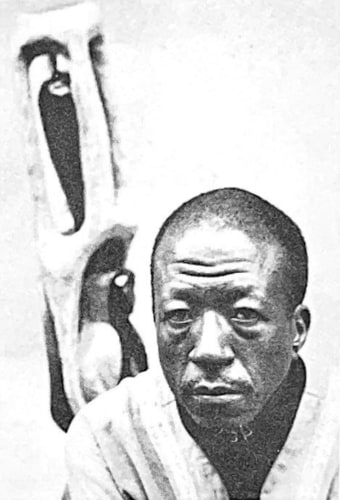

B. RAEFORD, NC, 1928
D. 2009
Anderson Pigatt was an African American self-taught sculptor who worked with wood and whose sculptures reflect a direct and uncompromising approach to the medium. Pigatt received vocational training in woodworking and carpentry at George Washington Carver High School. After serving in the United States Army from 1950–55, he studied cabinetmaking on the G.I. Bill. Working as an apprentice in Baltimore, MD, Pigatt learned to refinish and repair antique furniture. Pigatt restored furniture in New York at an antique house on Broadway after 1963 and performed as a doo-wop singer on the side, but didn’t launch his art career until the late 1960s. Around this period, he began whittling wood scraps in his free time because "he felt the spirit of the wood talking to him." His sculptural work explores themes of race and belonging, colonization, and memorial.
One of Pigatt’s earliest projects was in 1969, when governor Nelson Rockefeller unveiled a plan to build a State Office Building on 125th Street in Harlem. The proposal was greeted by strong opposition from the local community, and protesters occupied the area, renaming it “Reclamation site #1.” Pigatt received a call from a friend asking him to retrieve an old oak that had been cut down near the site, and when he arrived Pigatt was struck by the scene of police surrounding the gathered crowd. He recalled: “I could see this trunk of a tree with one branch that stood out like a thumb, and all around me the brothers and sisters were making black power salutes.” Pigatt was inspired to begin carving immediately, camping at the site with fellow artist Tonnie Jones to create his sculpture titled In Honor of the Brothers and Sisters of Reclamation Site Number One which became a monument to the people who struggled for many months to ensure that governmental development in the neighborhood would serve the interests of the Black community.
Pigatt founded the nonprofit A.J.P. Artist’s Workshop in Baltimore, with a gallery location opening in Greenwich Village in 1976. Pigatt ran the gallery with close friend Jeffrey Greene and exhibited his work alongside other Black artists such as Dindga McCannon, Willie Birch, Tom Feelings, Faith Ringgold, Jacob Lawrence, and Romare Bearden. The gallery’s list of artists also included Ellsworth Ausby and Joe Overstreet. The opening exhibition at the Soho location was a presentation of work by the folk singer Richie Havens, for whom Pigatt acted as a mentor after they met outside his East Third Street workshop called "True Creations from Vibrations." Andrew Hill played piano at the opening.
In 1994, Pigatt also founded the Baltimore Jazz Listening Society in order to promote and preserve the jazz tradition by establishing a scholarship fund for jazz studies, holding concerts, and developing a jazz archive. The largest project undertaken by the A.J.P. Artist’s Workshop was the proposal for the development of the Baltimore New Museum of African-American Folk Art, later renamed the Museum for Artists of African Descent. The business plan went through many iterations from 1995 to 1997 and was part of Pigatt’s enduring support for the transformation of Baltimore’s Howard Street into an “Avenue of the Arts” and his dream of promoting investment in the African American artist community.
Anderson Pigatt often recalled what his father said to him on his death bed—“What has man gained if he’s gained the world and lost his soul?” Pigatt felt that his sculptures held pieces of his soul, stating “I guess this is why I’m a woodworker, for you see, wood to me is always alive…these dead trees that I write stories on may last 1,000 years for the world to see.” Documenting scenes of discrimination and anger on wood became a process of translating human greed and hate into life and rebirth.
Pigatt’s work is represented in a number of private and institutional collections, including the Schomberg Center for Research in Black Culture in New York; the Brooklyn Museum, Brooklyn, New York; the Reginald F. Lewis Museum, Baltimore, MD; and the American Visionary Art Museum, Baltimore, MD. His work has been purchased by such notables as Singer Richie Havens, and artists Andy Warhol and John Biggers.